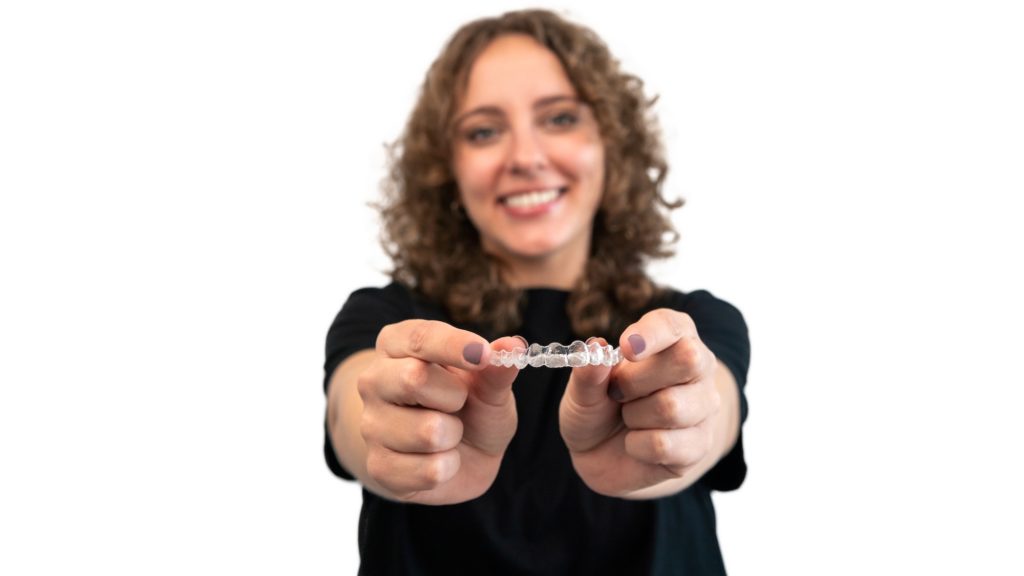How to Clean Retainers

Learn the best ways to clean and maintain your retainer to be sure you protect your investment and your teeth.
Table of Contents
If you’re wearing a retainer frequently, cleaning it and keeping your retainer clean is essential as it lives in your mouth! You would put any other small bacteria-infested things in your mouth, so why would you put a dirty one in there? A retainer that hasn’t been cleaned will have lots of bacteria since it will be in a moist and warm environment where bacteria can thrive. It will also collect plaque and tartar, which can lead to it smelling and tasting funny.
Here are some signs you may notice when cleaning is overdue:
- Small white spots
- Bad smell
- Bad taste
- Layer of film
- Cloudy look
How to Clean Your Retainer?
There are many ways to clean a retainer. You may have to clean it a certain way based on what it is made out of or what cleaning product you are using.
1. Plastic Retainer
For plastic retainers, it’s important to clean them right away after you remove them from your mouth, so they can be cleaned before anything has the chance to dry. This will make it easier to clean off any debris before it hardens.
Here are the steps on how to clean a plastic one.
- Brush it with warm water after you eat.
- When going for a deep clean, mix warm water and dish soap, then use a soft toothbrush to scrub away and clean the surface.
- For the deep grooves, use a cotton swab to clean the ridges.
- For soaking in a denture or retainer cleaner, it’s best to ask your dentist if that’s okay first. If everything is good, mix a cup of warm water with a cleaner tablet and follow the rest of the package instructions for how long to soak.
If any debris doesn’t come off, take it to your dentist or orthodontist, and they can use special solutions and a tool to remove stubborn particles.
2. Plastic Retainer
These types of retainers are attached to your teeth, so you have to floss them daily. This process is more complex, but after time it’s something that will come with ease. Here are the steps to making sure your retainer is squeaky clean.
- First, grab floss and use a floss threader to slide the floss in between your middle front lower teeth.
- Then hold the end of the floss and have the other end attached to the threader.
- Slide the floss under your retainer wire, and move it around, up and down, in between your teeth and gum line.
- Then move the floss sideways to the next part that needs to be cleaned.
- Keep doing this with each tooth that’s attached to your permanent retainer.
If you’re finding it difficult, ask your dentist or orthodontist for help, they can help guide you.
3. Retainer Case
While looking at the inside of your case, look for anything crusty inside. If any is spotted, wipe it clean with a wet paper towel or cleaning wipe.
Your case should never have any standing water inside. If you keep it sitting in standing water, bacteria will grow in the case, which will enter your mouth when you use it. If your case gets really dirty, which you can’t clean, you can always ask your orthodontist for a new one. They will be more than happy to give you a nice fresh one.
How to Clean Your Retainer At-Home?
Baking soda is a great at-home cleaning option for your retainer. You may notice more toothpaste now containing baking soda. Baking soda is great because it is a scrubbing agent and also helps with bacteria in your mouth without using harsh chemicals. It can also help with the color, preventing it from turning yellow.
When cleaning your retainer with baking soda, the first thing you need to do is make a paste that is made out of water and baking soda. You want to do 50% water, and 50% baking soda, so the paste is thick enough to stick. Use a toothbrush and scrub the baking soda paste into your retainer and then rinse the paste off when you are done scrubbing.
How to Make Your Retainer Not Stink?
Vinegar is a great option for cleaning retainers with bad odors. Since your retainer lives in your mouth, lots of bacteria will end up sticking to it, causing it to smell. White vinegar is a great disinfectant that removes odors. All you’ll need to clean your retainer is vinegar and water. You’ll want to make a mixture of 50% warm water and 50% vinegar. Once you have this mixture soak the retainer in it for about 20 minutes and make sure to rinse your retainer afterward, or you’ll be surprised by a strong taste!
Hopefully, this helped you understand how to clean a retainer. Make sure to clean it often to prevent it from getting covered in tartar and bacteria. A clean retainer won’t cause you to have a funny taste or smell coming from your mouth. It’s important to know what kind of retainer you have because of the differences in how each type is best cleaned. If you are unsure, you can always give your dentist or orthodontist a call. Likewise, if you have trouble cleaning parts, they can help you to get it nice and clean.
Retainer FAQs
A retainer is a custom-made dental appliance used to keep the position of teeth after orthodontic treatment, such as braces or clear aligners. It is often composed of plastic or metal. Once the braces or aligners are removed and the teeth are in their desired positions, it is prescribed to prevent them from shifting back to their original positions. Depending on the patient, retainers can be fixed or removable. They are usually worn for a specified time, such as months or even years, to ensure the long-term stability and alignment of the teeth. Regular use and maintenance are essential for maintaining the results achieved through orthodontic treatment.
A retainer is often advised for people who have had orthodontic treatment, such as braces or clear aligners, to straighten their teeth. After the orthodontic treatment and the braces or aligners are removed, the teeth return to their original positions.
Whether a patient needs one depends on various factors, including the initial alignment of the teeth, the complexity of the orthodontic treatment, and the individual’s oral habits. The orthodontist will assess each patient’s specific needs and recommend the appropriate type and duration of its use to maintain the desired outcome of the orthodontic treatment.
Establishing a regular cleaning routine is essential to clean your retainer correctly. Start by removing it from your mouth and gently rinse it under lukewarm water to remove any loose debris. Then, use a soft-bristle toothbrush and a mild liquid soap or non-abrasive toothpaste to brush it, paying attention to all surfaces and crevices. Rinse the retainer thoroughly to remove any residue.
You can soak the retainer in a denture-cleaning solution or a solution made of equal parts water and white vinegar for 15 to 30 minutes to help eliminate bacteria and odors. Rinse the retainer after soaking it, then put it back in your mouth or store it in a dry, clean case. Harsh chemicals or abrasives can damage retainers, so visit your orthodontist for special cleaning recommendations tailored to your retainer type.
It is important to clean your retainer regularly to maintain good oral hygiene. Generally, the recommendation is to clean it after you remove it from your mouth. This includes cleaning it after meals or snacks, as food particles can get trapped and lead to bacterial growth. Additionally, it needs cleaning if you notice any buildup, discoloration, or an unpleasant odor. A good practice is incorporating cleaning into your daily oral care routine, such as brushing your retainer every morning and evening. Regularly inspect for any signs of wear, damage, or accumulation of debris, and clean it promptly when needed.
By being proactive and maintaining a consistent cleaning schedule, you can ensure that your retainer stays fresh, hygienic, and effective in preserving the alignment of your teeth.
